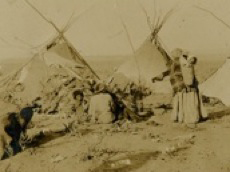Early Peoples: The Paiutes
|
The Paiutes are part of the Numic speaking peoples of the Uto-Aztecan language family. The Paiute dialect, Monoish Genus, or Northern Numic, began to form in about 500 A.D. when small family groups moved into eastern Nevada and southwestern Utah. The Northern Numic (Paiute) peoples either displaced or absorbed the preexisting Fremont culture and became the dominant group in the area by 1,000 A.D. The Paiutes were also influenced by the neighboring Anasazi in northern Arizona, adopting complex flood-plain gardening and agriculture. The Paiutes were able to exist and maintain a way of life without overtaxing the resources of the land. Their mobile lifestyle included moving frequently, primarily according to the seasons and plant harvests and animal migration patterns. They lived in independent groups of from three to five households. The largest concentration of Paiutes in Utah lived along the banks of the Santa Clara River. The Paiutes were highly sophisticated botanists. They used at least ninety-six different species of edible plants. They fished, hunted rodents, birds, reptiles, and insects. The major gatherings were centered around the pine nut harvest and the spring fish spawnin at Fish Lake. These gatherings were major social events.
|


 The wise wolf and oldest brother Tabuts decided to carve many different people out of sticks. His plan was to scatter them evenly around the earth so that everyone would have a good place to live. Tabuts had a mischievous younger brother, Shinangwav the coyote. Shinangway cut open the sack and people fell out in bunches all over the world. The people were angry at this treatment, and that is why other people always fight. The people left in the sack were the Southern Paiutes. Tabuts blessed them put them in the very best place.
The wise wolf and oldest brother Tabuts decided to carve many different people out of sticks. His plan was to scatter them evenly around the earth so that everyone would have a good place to live. Tabuts had a mischievous younger brother, Shinangwav the coyote. Shinangway cut open the sack and people fell out in bunches all over the world. The people were angry at this treatment, and that is why other people always fight. The people left in the sack were the Southern Paiutes. Tabuts blessed them put them in the very best place.

